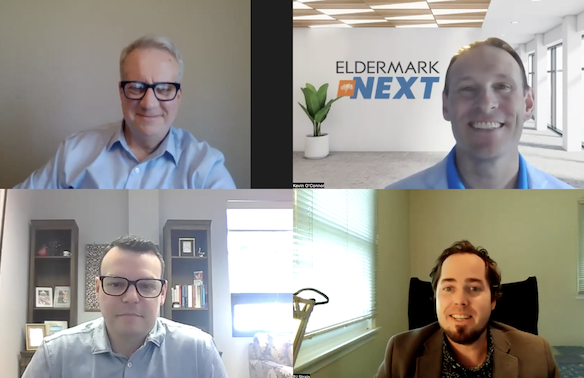Retaining Your Best: Strategies for Staff Retention in Senior Living Communities

After years of uncertainty, the staffing shortage in senior living is far from over, and it reflects a nationwide trend that continues to disrupt numerous industries. In fact, a recent Gallup poll shows that nearly half (48%) of workers across the country are actively looking to switch employers. Senior living staffing retention is a challenge, but it doesn’t have to be an impassable obstacle.
By understanding what causes staff retention issues and the ways you can prevent turnover, you can keep your top talent and improve your employee and resident satisfaction rates.
Understanding the Causes of Senior Living Staff Turnover
First, it’s important to know why employees leave for greener pastures — it doesn’t always have to do with the money. The aforementioned Gallup poll actually shows that dissatisfaction with pay as a reason for quitting is actually on the decline. So what is causing caregivers to leave?
Culture and Engagement
Toxic work cultures lead to disengaged employees, and that leads to turnover. Employees cite issues with a lack of career development, advancement opportunities, misalignment with corporate values, and unrealistic expectations as significant reasons to go on the job hunt.
Work-Life Balance
With burnout on the rise, especially in healthcare and healthcare-adjacent fields, mental well-being has become a far greater priority for many employees, and it needs to be a priority for employers, too. Work-life balance concerns may include those around PTO policies and benefits that cover mental health, along with flexible work schedules and the ability to work remotely. Work-life balance is an especially sensitive subject for care workers, as they tend to take on a greater share of the burden and are less likely to ask for help (often because they don’t feel they can or should).
Leadership
Generally, employees don’t leave because of issues with the leaders at the top of the organization — they leave as a result of clashes with direct management. Feeling out-of-sync with a supervisor leads to miscommunications and misunderstandings, which then sends many employees out the door.
Compensation
Of course, while pay isn’t the only issue or even the biggest issue in staff turnover, it would be naïve to think it doesn’t matter. However, salary isn’t the only consideration when looking at compensation and retention. Non-salary benefits like health insurance, sick time, retirement planning, and more are all a factor in making an employer more (or less) appealing to job seekers.
The Great Resignation is far from over, and if you’ve noticed signs of quiet quitting (calling off work, missing deadlines, lack of enthusiasm, putting in the bare minimum, etc.), you need to take action before it turns into actual quitting and leaves your team in the lurch.
Check out our free ebook on staffing and occupancy for clear, actionable tips.
Comprehensive Strategies for Staff Retention
Staffing levels at senior living and assisted living communities will always fluctuate, but with the right strategies in place, you can reduce turnover and improve stability, all while keeping residents safe, healthy, and happy. Here’s how:
Offer Competitive Compensation and Benefits
As mentioned, compensation is much more than a paycheck — it encompasses all the ways you acknowledge the time, effort, and energy every staff member puts into their work. Be sure salaries are competitive with other communities of the same size and in the same geographic location, but also look for out-of-the-box ways to show your best talent how much you appreciate what they do. Consider implementing a bonus structure if you don’t already have one, with goals they can work toward. If big annual bonuses aren’t in your budget, explore ways to provide incentives in real-time, like providing gift cards managers can distribute when they see someone going above and beyond.
Compensation also includes benefits, so take a look at your providers on a regular basis to ensure you’re offering top-notch health insurance, competitive retirement plans, employer matching, and subsidization of premiums.
Foster Professional Growth and Development
Lack of career advancement is one of the top reasons a good employee becomes a job seeker, so make sure your staff always has a clear path forward. Skills benchmarking is a good place to start and will help you assess each employee and create an individualized growth plan. Offer in-house training when possible, or help employees pursue training and education outside your community. Create a budget for staff development that can be used for training courses, conference attendance, professional association memberships, and more.
Enhance Work-Life Balance
If we learned anything from the early 2020s, it’s that the line between work life and personal life is easily blurred, and over time, it becomes out-of-balance and eventually unhealthy. Those employees in fields associated with healthcare and senior care take on even more of the burden, leading to burnout and other mental and physical health issues.
Put a plan in place to support them in maintaining their balance and protecting their time. This includes a communications protocol that maintains transparency and urgency while still respecting the boundaries of individual employees. Additionally, look for opportunities to make work schedules more flexible and more accessible. After the pandemic, employees are more likely to want or even expect opportunities for remote work and asynchronous schedules. This won’t be possible for every employee all the time, but it can help to look for ways to increase flexibility and support employees in managing their work lives and their home lives.
Cultivate a Positive Work Environment
Whether employees are at home or on-site, their environment can significantly impact their quality of work and the attitudes they have toward their employer. Creating a positive and meaningful work culture starts with strong values. If you don’t know the values of your community, it’s time to put them in writing and start displaying them for employees to see in action. From there, look for ways to make work a safe, stimulating, and enjoyable environment. Ensure that managers are trained in DEI and that they know how to implement your communication strategy in a way that makes employees feel secure and safe if and when they need to reach out.
Once values, safety, and communication are all solid, build on that foundation with cultural elements that make work fun. Create a plan to help employees and teams build relationships, like off-site activities, games, or friendly competitions. Make sure that any remote staff members are also included, as culture matters even more to those working from home.
Use Technology to Ease Workload
Automation is on the rise in the senior living field, and some employees may feel skeptical of it or even threatened by it. Ease their concerns by providing them with comprehensive training to better use all the available technology platforms. Make sure they know that working with the technology and not against it will ease their burden and make their work smoother and more seamless.
Empower leadership to get more involved with technology as well and learn how using analytics software can help them support employee productivity.
Also remember that mobile apps are becoming increasingly important to employees who may need to check in or finish tasks on-the-go. Seeking software with this type of accessibility simplifies processes and ensures continuity of work.
Tips On Implementing Staff Retention Strategies
Not sure how to actually put any of these ideas into practice? We’ve got you covered. Here are steps you can take to get started:
- Read up on the most effective hiring trends for senior living communities.
- Plan an audit phase: audit your existing policies, existing software platforms, and existing budget, and look for ways to make improvements from a staff retention perspective.
- Work on updating or building your communications, technology, compensation, and engagement strategies.
- Consider vendor consolidation to lessen the number of technology providers and make training/onboarding a simpler process for staff members.
How Implementing Eldermark NEXT Can Help With Staff Retention
Having the right software in your tech stack is vital to reducing employee turnover. Expecting employees to learn and manage an overwhelming number of platforms puts them under undue stress, wastes their time, and makes your community less efficient.
Instead, look for an all-in-one solution like Eldermark NEXT, which offers smooth and frictionless onboarding for employees, a mobile app for on-the-go use, and seamless integration across functions for error reduction and greater ease. Plus, your leadership will benefit from Eldermark’s resource planning capabilities and in-depth analytics, so they can make informed decisions that keep employees satisfied.
We all know satisfied employees mean satisfied residents. Learn more about Eldermark NEXT and schedule a demo today!



